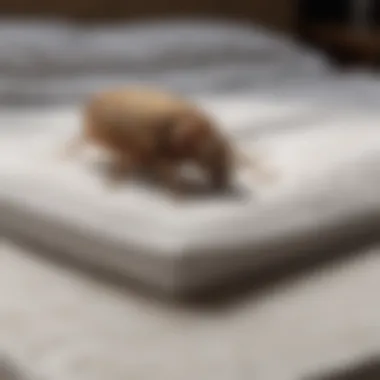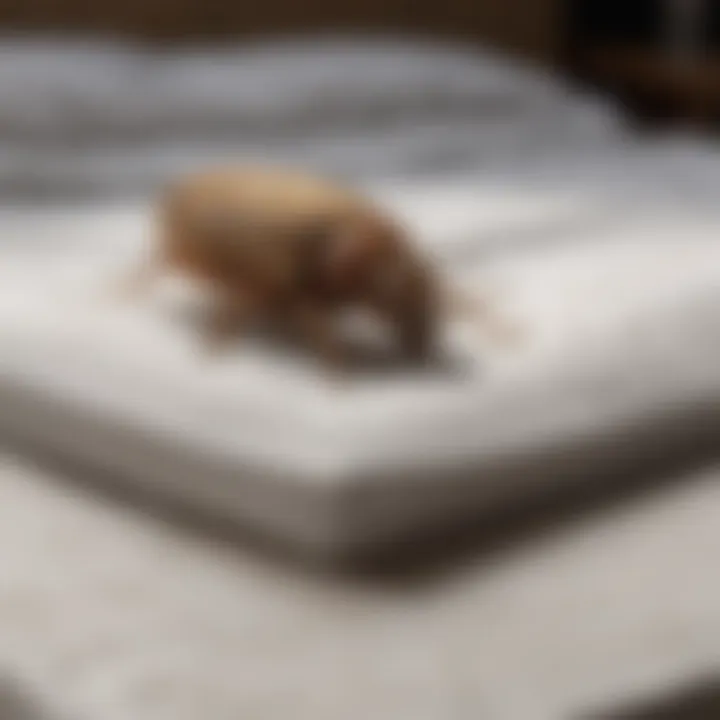Understanding Bed Interceptors in Pest Management


Intro
When faced with a growing concern like bedbug infestations, it becomes paramount to understand pest management techniques that are effective, practical, and eco-friendly. The introduction of bed interceptors has revolutionized pest control strategies, offering homeowners a beacon of hope against these tenacious pests. This article aims to explore the multifaceted world of bed interceptors, shedding light on their applications, significance, and the innovative methodologies employed for their effective use.
Understanding Pests
Understanding pests is the first step in effectively managing them. Referred to as organisms that cause damage to our homes, health, and well-being, pests can range from insects like bedbugs to rodents, which are not only troublesome but can also affect our quality of life.
Definition of Pests
Pests are defined as any species that negatively impacts human activities or habitation. In many cases, they reproduce quickly and can thrive in various environments, making them challenging to eliminate.
Importance of Pest Identification
Identifying these pests is crucial for employing the right control strategies. Without a precise understanding, one might end up using ineffective measures or, worse, aggravating the situation. The discerning homeowner recognizes that bedbugs, for instance, can hide efficiently within crevices, making detection a difficult task without proper tools.
Prevention Techniques
Prevention is often the best strategy when it comes to pest control. In particular, homeowners should be proactive in safeguarding their environments against bedbugs and other nuisances.
Home and Garden Preventative Measures
- Seal Cracks and Crevices: Inspect your home for any gaps around windows, doors, and baseboards. Sealing these can prevent pests from entering.
- Regular Cleaning: Maintaining cleanliness in your home diminishes the chances of attracting pests. Regular vacuuming is essential, especially in areas where people sleep.
- Monitor Secondhand Furniture: Purchasing used furniture can lead to surprises. Always inspect it thoroughly before bringing it home.
Seasonal Prevention Tips
- Spring Cleaning: As the weather warms, tackle those areas that often get overlooked, such as attics or basements, to eliminate potential hiding spots.
- Winter Maintenance: During colder months, keep your home insulated. Even the smallest gaps can provide entry points for pests seeking shelter.
Eco-Friendly Pest Control Solutions
In an age where environmental sustainability matters, homeowners are increasingly seeking eco-friendly pest control methods. This section presents practical suggestions that align with sustainable practices.
Overview of Sustainable Practices
- Integrated Pest Management (IPM): This methodology combines biological, cultural, and physical controls to manage pests effectively while minimizing harm to the environment.
- Use of Native Plants: Choosing plants that are native to your region can discourage pests naturally. Local flora tends to be more resilient against local pests.
Natural Remedies and Their Effectiveness
Experiments with natural pesticides have shown promising results. For example, diatomaceous earth, a non-toxic powder, can deter insects by damaging their exoskeletons, leading to dehydration. Another popular home remedy includes essential oils, like peppermint and lavender, known for their repellent properties.
"The best defense begins with understanding and prevention, equipping yourself with knowledge and tools.
With awareness of pests, proactive steps in prevention, and a commitment to eco-friendly methods, homeowners can both manage pest issues effectively and create a healthier living space. In the subsequent sections, we will delve into the specifics of bed interceptors, examining their design, usage, and how they can complement a comprehensive pest management strategy."
Intro to Bed Interceptors
In the world of pest management, bed interceptors are indisputably invaluable. For many homeowners, the creeping dread of bedbug infestations looms large—these small, nocturnal nuisances can disrupt sleep and wreak havoc on one’s peace of mind. Here, understanding the significance of bed interceptors can be a game changer. These tools not only play a critical role in detecting bedbugs but also assist in managing infestations effectively. Their straightforward design and advanced functionality offer a solid first line of defense against these unwanted intruders.
Definition and Functionality
Bed interceptors are primarily designed to detect and trap bedbugs as they attempt to move to and from a resting place, such as a bed or couch. Essentially, they act as traffic control for bedbugs, capturing these pests before they can cause havoc. The functionality is quite simple: the interceptors usually consist of a hollow base with ridges or other barriers that bedbugs can’t easily climb over, ensuring that once they land, they’re unable to escape. This design allows homeowners to monitor and identify any potential infestations early.
Additionally, bed interceptors come in various shapes and sizes, whether they fit under bed legs or sofas. The effectiveness of these devices lies in their ability to help users ascertain the presence of bedbugs without the need for harmful chemicals or in-depth pest control procedures. Plus, given today’s eco-friendly trends, many interceptors are made from non-toxic materials which only adds to their appeal.
Historical Context
From a historical standpoint, the concern over bedbugs stretches back centuries. They have been pesky companions to humanity, noted in texts dating back to Roman times. The late 19th and early 20th centuries saw the rise of industrialized housing, which inadvertently paved the way for these critters to flourish in urban environments.
As society advanced, so too did pest control methods. The introduction of various sprays and fumigants showed improvements but also revealed limitations and associated health risks. Amidst this struggle, bed interceptors emerged as a vital adjunct to existing pest control tactics. They provided a proactive approach, enabling homeowners to detect potential outbreaks before they spiraled out of control.


Understanding Bedbug Infestations
When it comes to pest management, grasping the nuances of bedbug infestations is crucial. Not only do these unwanted guests disrupt sleep patterns, but they also lead to significant mental distress in households. Understanding where they come from and how they behave can arm homeowners with the knowledge needed to tackle these infestations head-on.
Behavior and Biology of Bedbugs
Bedbugs, scientifically known as Cimex lectularius, are small, elusive creatures that thrive on human blood. Their nocturnal nature means they come out to feed during the night, often leaving behind itchy bites on exposed skin. But how do they find their victims?
These pests are equipped with a keen sense for carbon dioxide, which humans exhale. This means they can detect when a potential meal is nearby, enabling them to travel great distances to feed. Bedbugs reproduce quite rapidly; a female can lay dozens of eggs in a single week, leading to exponential growth in their numbers if not managed promptly.
Aside from their feeding habits, bedbugs can also be quite resilient. They can survive months without a meal and are capable of hiding in the tiniest of crevices—from mattress seams to the back of picture frames. Their flat bodies make it easy for them to slip into hard-to-reach places, making thorough inspections essential.
Signs of Infestation
Recognizing the signs of a bedbug infestation is an essential first step in the management process. Here are the common indicators homeowners should be vigilant about:
- Bite Marks: Often appearing in clusters or linelike patterns, these bites can cause significant itching and discomfort.
- Fecal Spots: Tiny brown or black specks found on bedding or furniture can be a telltale sign of bedbug presence. These spots are, in fact, digested blood expelled by the bugs.
- Eggs and Shed Skins: Bedbug eggs are around the size of a pinhead and are white; they can usually be found in hidden nooks. Additionally, discarded skins from molting are common and indicate a growing infestation.
"A stitch in time saves nine—addressing bedbug signs early can prevent a burgeoning infestation."
Serious infestations may also lead to the presence of bedbugs in other areas of a home. This underscores the importance of a proactive approach to inspection and management. By learning to identify these signs early, homeowners can reduce the risk of a full-blown invasion.
In summary, understanding the behavior and biological attributes of bedbugs, along with recognizing the signs of infestations, sparks the initial steps toward effective pest management. Such knowledge not only aids in prevention but also equips homeowners with confidence to take action when faced with these persistent pests.
Mechanics of Bed Interceptors
Understanding the mechanics of bed interceptors is essential, not just for pest management professionals, but for homeowners and anyone seeking to reclaim their spaces from the nuisance of bedbug infestations. These ingenious devices, while varying in design and functionality, share a common purpose: preventing bedbugs from reaching their desired resting spots. Each component of the interceptor works synergistically, providing a first line of defense. This section delves into the design features and various types of bed interceptors, showcasing their benefits and considerations that matter most.
Design Features
When examining the design features of bed interceptors, one sees the meticulous engineering that sets them apart in pest control.
- Barrier Mechanisms: Bed interceptors often incorporate barriers that effectively prevent bedbugs from crawling over them. This could mean raised edges or specialized materials that bedbugs find difficult to navigate.
- Multiple Entry Points: Many models provide various entry points to maximize efficiency. This design allows interceptors to capture bedbugs from different angles and minimize the chance of escape.
- Durability: Given the environments in which they are placed, durability is a critical feature. Most bed interceptors are made from robust materials that resist wear and tear, making them suitable for long-term use.
These design elements showcase why bed interceptors can be so effective, giving homeowners peace of mind while dealing with a potential infestation.
Types of Bed Interceptors
With the mechanical mechanics defined, let's explore the specific types of bed interceptors, each formulated to cater to different situations and user needs.
Passive Interceptors
Passive interceptors rely on design over electronics or any active detection. Their key characteristic is their simplicity of use. These devices often take the form of circular or triangular barriers placed underneath furniture legs, especially beds. Their main contribution to pest management is the establishment of a physical barrier that bedbugs must cross.
One significant advantage of passive interceptors is their low maintenance. They don’t require power or constant attention. However, they do have their limitations, such as the fact that they cannot actively guide bedbugs toward them; the bedbugs must wander into the interceptor’s site. That being said, these interceptors are a frequently chosen option, recognized for their ease of use and reliability over time.
Active Interceptors
Active interceptors introduce electronics into the equation, often employing a combination of attractants and traps. These are a more sophisticated approach to pest management. One key aspect of active interceptors is the inclusion of pheromones or heat as attraction methods to lure bedbugs into a designated trap area.
Their primary advantage lies in their ability to attract pests, which can often lead to higher collection rates compared to passive approaches. However, they typically require a power source, and maintaining them can become a chore, especially if they are integrated with complex monitoring systems. Homeowners must weigh these pros and cons when deciding if active interceptors are right for their situation.
Sticky Traps
Sticky traps have gained popularity due to their straightforward functionality. As the name suggests, these traps use an adhesive surface to capture bedbugs that wander onto them. Their key characteristic is the instant monitoring capability they provide, as users can easily inspect the traps to assess for any unwanted critters.
Sticky traps are particularly beneficial in crowded spaces or during outbreaks, as they can catch multiple bedbugs in a short period. However, it’s essential to consider their downsides, such as the potential for false positives. These traps may sometimes capture non-threatening insects or debris, leading to unnecessary worry or confusion. In sum, while sticky traps provide immediate visual feedback, users must ensure correct interpretation of results to avoid missteps in pest management strategy.
The effectiveness of each type of bed interceptor hinges on various factors — understanding these nuances can significantly enhance pest control strategies.


Application of Bed Interceptors in Pest Management
Bed interceptors play a vital role in pest management, especially when it comes to the control of bedbug populations. As homeowners grapple with the growing challenge of these resilient pests, understanding the application of bed interceptors is essential. These devices not only assist in detecting the presence of bedbugs but also contribute significantly to minimizing infestations before they spiral out of control. Let’s explore how they fit into a comprehensive pest management strategy.
Placement Strategies
When it comes to effectively utilizing bed interceptors, placement is key. Strategic positioning can make a night-and-day difference in catching those pesky critters. Here are a few cornerstone strategies to consider:
- Around Sleeping Areas: Placing interceptors under bed legs or within a few feet of mattress edges ensures that if bedbugs are active during the night, they’ll find their way into these traps.
- High Traffic Zones: Consider spots in the home that see regular movement, such as alongside furniture or doorways. By placing beds interceptors here, you increase the chances of intercepting a bedbug before it ventures into a hidden area.
- Multiple Levels: If you have a multi-story home, don’t neglect the upper floors. Bedbugs can easily hitch a ride on clothing or luggage, spreading throughout the house. So, placing interceptors on each level can act as a first line of defense.
Additionally, using a mix of interceptors can help maximize coverage. For instance, pairing sticky traps with passive interceptors could provide a broader safety net.
Monitoring Techniques
Effective monitoring is crucial for pest control. The use of bed interceptors aids in this process by offering homeowners a scientifically-backed way to track pest activity. Here are some useful monitoring methods:
- Regular Checks: Establish a routine to check the bed interceptors weekly. This practice allows for timely intervention at the first signs of an infestation. If you start spotting bugs, you'll want to act fast before they have a chance to multiply.
- Document Observations: Keeping records of what you find can help identify patterns over time. Note when and where bugs are caught; this info might reveal hotspots in your home that need addressing.
- Combine With Visual Inspections: Use visual checks alongside interceptors. Inspect mattresses, box springs, and other areas known for bedbug habitation. Keeping a keen eye on these regions can enhance the effectiveness of your monitoring efforts.
"Prevention in pest management is like keeping an umbrella handy before the storm; it’s not about if it will rain, but when it will rain."
In summary, the effective application of bed interceptors, through strategic placement and conscientious monitoring, can dramatically enhance your approach to pest management. Not only do these techniques alleviate potential bedbug issues proactively, but they also empower homeowners with the tools necessary for ongoing vigilance.
Effectiveness of Bed Interceptors
When it comes to battling bedbug infestations, understanding the effectiveness of bed interceptors is crucial. These tools are not just a stopgap; they play a vital role in integrated pest management, serving as the frontline defense against these unwelcome squatters. Their effectiveness lies in their ability to provide immediate feedback on the presence and movement of bedbugs. This ability is essential for framing pest control strategies and assessing the overall infestation status in your home.
Several key aspects come into play when evaluating the effectiveness of bed interceptors:
- Detection Reliability: This factor speaks volumes about how well these devices can identify bedbug activity. A reliable interceptor will yield consistent and accurate results, increasing your chances of timely interventions.
- Ease of Use: One cannot understate the importance of user-friendly designs. If the interceptor is easy to set up and maintain, it encourages regular monitoring. The more you check, the quicker you identify and respond to any potential infestations.
- Cost-Effectiveness: Investing in bed interceptors can be economically wise when compared to the costs associated with professional extermination services. Ongoing monitoring reduces the likelihood of severe infestations that require extensive treatment.
"A stitch in time saves nine"—this old adage rings particularly true when it comes to utilizing bed interceptors. By catching an infestation early on, you can save yourself both money and stress.
- Integration with Other Methods: Bed interceptors shouldn't live in isolation. Their effectiveness increases when used alongside other pest control strategies, forming a comprehensive defense system. This synergy can lead to more robust and sustainable outcomes.
Understanding the effectiveness of bed interceptors doesn't just help with current infestations but also arms homeowners with valuable data to prevent future issues.
Case Studies and Evidence
Numerous case studies shed light on the efficacy of bed interceptors in real-world situations. One interesting example comes from a multi-family housing unit in a suburban neighborhood. After initial complaints of bites, management implemented bed interceptors across all units. Within just a few months, the interceptors indicated a drastic reduction in bedbug activity. This evidence was instrumental in guiding further treatment strategies, showcasing how data from bed interceptors can inform pest management more broadly.
Another compelling case emerged in a hotel setting, where bed interceptors served to monitor guest rooms frequently occupied. These interceptors detected the presence of bedbugs before guest complaints arose. This proactive approach not only saved the hotel from a public relations nightmare but also displayed how early detection through simple monitoring tools can preserve hospitality business reputation.
Comparative Analysis with Other Methods
When juxtaposing bed interceptors with other pest control methods, several points stand out:
- Versus Chemical Treatments: Unlike chemical treatments that get to work immediately but don't provide long-term monitoring, bed interceptors continuously track bedbug movement and activity over time. This ongoing data stream is invaluable for identifying potential future infestations.
- Versus Traps: Traditional traps can sometimes underperform in capturing specimens that evade detection due to their placement or design. Bed interceptors, on the other hand, have been specifically engineered to maximize their catch rates, making them a superior choice for diligent homeowners.
- Versus Professional Extermination: Hiring professionals can certainly be effective, but it's often costly and may require multiple visits. Having bed interceptors in place allows homeowners to have a first line of defense, often preventing the need for such drastic measures.
Limitations and Challenges
The effectiveness of bed interceptors in pest management comes with both benefits and potential drawbacks. Identifying the limitations and challenges provides a clearer picture of how these tools fit into a broader pest control strategy. Understanding these aspects allows homeowners and pest control professionals to make informed decisions, ensuring a more effective fight against bedbug infestations.
False Positives and Negatives
Bed interceptors are generally useful, but they are not foolproof systems. One significant challenge is the phenomenon of false positives and negatives. A false positive occurs when an interceptor indicates the presence of bedbugs where none exist. This can lead to unnecessary panic and costly treatments that may not be needed. House owners might be prompted to conduct extensive pest control measures based on what turns out to be a false alarm. This situation often arises due to the design of the interceptor or how it is placed. For instance, if an interceptor is situated near furniture or other clutter, it may trap non-target insects, leading to misleading results.
Conversely, false negatives reveal an even more concerning issue. A bed interceptor may fail to capture bedbugs that are active but do not venture near it. Factors such as the layout of the room, the behavior patterns of the bedbugs, or even the specific style of bed being used can affect the accuracy of these devices. In some cases, bedbugs may just bypass the interceptor altogether, allowing infestations to persist unnoticed. This potential oversight emphasizes the importance of using bed interceptors in tandem with other monitoring strategies to ensure greater accuracy in pest detection.
User Error in Implementation


User error is another significant challenge when it comes to bed interceptors. Proper installation and maintenance are crucial for effective monitoring. If a homeowner misplaces an interceptor or fails to check it regularly, it diminishes its efficacy substantially. For example, if an interceptor is not placed correctly beneath bed legs, it may not effectively capture any bedbugs that travel from nearby areas. Many interceptors need to be washed or checked periodically to ensure they are functioning well, and neglecting this aspect can lead to misleading results.
Moreover, lack of awareness regarding how these devices function can lead to improper use. Many house owners may underestimate the need to check their interceptors frequently or may not follow the recommended protocols for their position relative to the bed or other furniture. It's essential to understand that they are only one part of a larger pest management approach. Education about the proper use and care of bed interceptors is vital to maximize their potential.
Understanding the limitations and potential errors in using bed interceptors allows home owners to better integrate these tools into a comprehensive pest management plan.
Best Practices for Utilization
When it comes to managing bedbug infestations, employing bed interceptors is a crucial strategy. However, the true effectiveness of these tools is contingent on following best practices for their utilization. This section emphasizes the significance of proper use and maintenance of interceptors, with an eye toward alleviating infestations effectively.
Routine Inspection and Maintenance
Routine inspection is a linchpin of bed interceptor effectiveness. It's not just about setting the traps and letting them do their thing; an active approach yields better results. Check your interceptors regularly, perhaps once a week. This routine should involve:
- Removing debris: Dust and debris can obscure signs of bedbugs. Keeping the surfaces clean ensures that any potential signs of an issue are easily detected.
- Monitoring activity: Keep a keen eye on what the interceptors catch. This data is invaluable for forming a clearer picture of how serious the infestation is and whether your approach is working.
- Replacing old interceptors: Over time, traps lose their efficacy. It's essential to replace them regularly—most manufacturers suggest changing them every six months.
In addition, maintain a clean environment around the bed area. Regular vacuuming and reducing clutter can further deter bedbugs from settling in.
"Routine inspections can save you a world of trouble before a small problem balloons into a full-blown infestation."
Integration with Integrated Pest Management
Integrating bed interceptors into a comprehensive Integrated Pest Management (IPM) plan elevates your pest control game. IPM takes a holistic view, combining various approaches for effective pest control. Here’s how to weave bed interceptors into your IPM strategy:
- Combining strategies: Use interceptors alongside other methods such as insecticide treatments and professional extermination services. This layered approach increases your chances of effectively managing bedbug populations.
- Educating yourself and others: An informed homeowner is a prepared homeowner. Learn about bedbug behavior and lifecycle to tailor your trapping strategies.
- Keeping detailed records: Document the activity observed in interceptors. These records become vital for assessing trends and changes in bedbug activities, fostering better decision-making.
Future Developments in Bed Interceptor Technology
The landscape of pest management is ever-evolving, and bed interceptors are no exception. Advancements in technology continually open doors for better reliability and efficiency. Understanding how these developments can enhance bed interceptor efficacy is essential for homeowners and pest control professionals alike. In this section, we will discuss innovations in design and the possibility of integrating smart technologies into these crucial tools.
Innovations in Design
As we delve into the future of bed interceptors, it's important to focus on how design innovation can make a significant difference. Manufacturers are increasingly experimenting with materials and shapes to create interceptors that not only trap pests more effectively but are also easier for users to handle. New designs might incorporate features such as:
- Enhanced Aesthetics: Consumers often dismiss pest control equipment because of their unsightly appearances. A bed interceptor that blends seamlessly with home decor would encourage wider usage.
- Multi-functional Capabilities: Future models may combine the trapping functions of interceptors with detection abilities, alerting users when pests are near.
- Eco-friendly Materials: With a growing focus on sustainability, innovations in biodegradable or recyclable materials could draw in conscientious consumers.
Ultimately, blending practicality with modern design creates devices that homeowners feel comfortable using in their personal spaces.
Potential for Smart Technology Integration
Integrating smart technology with bed interceptors represents a significant leap forward in pest detection and management. With the rise of the Internet of Things (IoT), homeowners could soon have the ability to monitor bedbug activity in real-time, enhancing convenience and efficacy. Advantages of such integration might include:
- Mobile Alerts: Notifications sent directly to a smartphone or device can inform users when bedbugs are detected. This immediate feedback allows for rapid response.
- Data Analysis: Advanced algorithms could analyze patterns and trends in pest activity, helping homeowners understand infestation peaks over time, thereby allowing for more effective treatment strategies.
- Remote Monitoring: The potential to check interceptor status while away from home could afford peace of mind to those who travel frequently or manage rental properties.
The convergence of cocktail of smart design and technology underscores a pivot towards convenience while enhancing pest management practices.
"Innovation is the ability to see change as an opportunity - not a threat.”
Ending
Summary of Key Insights
In summation, a few key insights have emerged throughout this exploration:
- Functionality of Bed Interceptors: These devices act as a first line of defense against bedbugs, offering clues about their presence even before a full-blown infestation occurs. This early detection is paramount.
- Mechanics Behind Their Design: Various types of interceptors—passive types that rely on physical barriers, active versions that lure pests in with enticing bait, and sticky traps that ensnare intruders—each serve unique functions that can be tailored to specific household needs.
- Integration in Pest Management: Routine monitoring of bed interceptors, along with proper placement, can significantly bolster the effectiveness of broader pest control strategies, forming a symbiotic relationship with integrated pest management practices.
- Future Directions: Looking ahead, technological advancements like smart interceptors equipped with sensors could revolutionize how we monitor and control bedbug populations.
As the conversation around pest management continues, bed interceptors can no longer be viewed as mere passive devices. They are essential tools—informative and proactive, intertwining the art of prevention with modern science.
Call to Action for Effective Pest Management
For homeowners and housewives, the message is clear: be proactive. The journey to effective pest management begins with the understanding and implementation of bed interceptors. Here are some actionable suggestions to consider:
- Regularly Inspect: Make it a habit to check bed interceptors at least once a week. The earlier you spot an issue, the easier it is to manage.
- Educate Yourself and Others: Knowledge is a powerful weapon against pests. Share insights with friends or family so they can also implement effective monitoring techniques within their homes.
- Integrate with Broader Strategies: Don’t rely solely on interceptors. Combine them with good sanitation practices and professional pest control when necessary to create a comprehensive management plan.
- Stay Informed About Innovations: Keep abreast of new technology and methodologies in pest management. Adapting to new advancements can help you stay one step ahead of any potential infestations.
"Effective pest management is not just about eliminating pests but creating an environment that is less hospitable to them."
In closing, investing time and resources into understanding and utilizing bed interceptors positions homeowners to face the pest phenomenon head-on, ensuring peace of mind and a healthy living environment.



